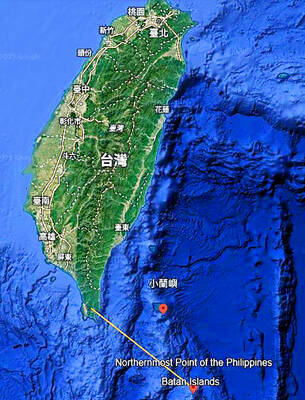Farming plankton, sending solar panels into orbit, remodeling hydrogen — for the latest wave of entrepreneurs suggesting easier ways out of climate change, it’s all in a day’s pitching.
Beyond grabbing headlines, such notions are attracting serious scientific attention and venture funding from investors who at least until the collapse of Lehman Brothers lent credibility to high-risk investment propositions.
Some plans seek radical alternatives to fossil fuels. Other businesses are dreaming of geoengineering — planning to tweak the earth’s climate by removing heat-trapping carbon dioxide or reflecting sunlight into space.

PHOTO: REUTERS
Among new energy fixes presented to Reuters in recent days is US-based BlackLight Power.
The company says it may have tapped the energy that cosmologists have struggled to explain, called dark matter, which fills the universe. The concept involves shifting electrons in hydrogen molecules — obtained cheaply from water — into a lower orbit, releasing energy in the process.
“It represents a boundless form of new primary energy,” founder Randell Mills said in a phone interview.
“I think it’s going to replace all forms of fuel in the world,” he said.
Britain’s top science academy, the Royal Society, this week urged more funds be channelled into research on geoengineering, but for some climate commentators the unproven, technical solutions smack of society’s craving for pain-free get-outs.
They said politicians might prefer to feed that habit rather than face tough choices in redressing global warming.
Greenpeace chief scientist Doug Parr said geoengineering projects would be seized upon by polluters as a quick fix, and the former climate change adviser to oil firm BP said they were simplistic.
“People are being naive ... looking for a technological fix,” said Chris Mottershead, who is now head of research and innovation at King’s College London.
“Anything of the necessary scale will have its own unintended consequences, even if they are not recognized at the moment,” he said.
Since 1991, BlackLight’s founder said his company has raised US$60 million from private investors who have included the former chairman of Morgan Stanley, Dick Fisher and the bank’s now retired head of energy. Mills says his goal is to produce a 250 kilowatt prototype by the end of next year.
The estimated capital cost of the energy at US$500/KW would be less than coal power, one of the cheapest forms of energy now. Several utilities have bought licences, in case it works.
Last month New Jersey-based Rowan University engineers said the BlackLight process in the lab had produced heat some 1.6-6.5 times beyond levels that can be easily explained.
“It does portend some type of novel energy source,” said Peter Jansson, associate engineering professor at Rowan.
In another energy fix, California-based Solaren wants to launch solar panels into orbit to send back radio waves which can generate electricity back on Earth — and benefit from the sun shining 24 hours a day in space.
“It’s not like a laser or a bug zapper or anything like that,” founder and CEO Gary Spirnak said. “I think this could be like any other large power source, 20-25 percent of the world’s electricity, 30 or 40 years out.”
Solaren aims to produce electricity from a 200 megawatt prototype by 2016 at a cost of several billions of dollars per plant.
“It’s a little expensive for a 200 megawatt plant. We’ll do a bit better than break even,” he said.
Spirnak said his company has raised “the equivalent of US$20-30 million from financial groups and private investors” and signed a power-purchase agreement with Californian utility PG&E, whose Web site shows a request for approval for power generated in this way from California’s Public Utilities Commission.
In case the world can’t contain its carbon emissions, among geoengineering fixes, Dan Whaley, founder and chief executive of California-based Climos, hopes tiny plankton that live on the ocean surface can be used to absorb carbon dioxide as they grow.
“These are not silver bullet solutions, but things that might take the edge off,” he said. “What is the risk of doing nothing? We think it’s so extraordinary it’s apocalyptic. These geoengineering projects, the research into this, is an exercise to reduce future risk.”
Global plankton deployment across 40 percent of the world’s oceans for 50 to 100 years could remove 1 billion to 8 billion tonnes of carbon emissions per year from the air, he said. That compares with annual manmade emissions now of about 32 billion tonnes.
Whaley, who says he has raised US$3.5 million from investors, plans to roll out the scheme over five or 10 years on a very small scale, “to increase our ability to model the environment.”
But he acknowledges a risk. Experts have pointed out that the plankton that die will sink several kilometers to the ocean’s depths, a rotting mass that may create oxygen-starved, dead zones on the floor of the oceans — a toxic prospect.

SECURITY: As China is ‘reshaping’ Hong Kong’s population, Taiwan must raise the eligibility threshold for applications from Hong Kongers, Chiu Chui-cheng said When Hong Kong and Macau citizens apply for residency in Taiwan, it would be under a new category that includes a “national security observation period,” Mainland Affairs Council (MAC) Minister Chiu Chui-cheng (邱垂正) said yesterday. President William Lai (賴清德) on March 13 announced 17 strategies to counter China’s aggression toward Taiwan, including incorporating national security considerations into the review process for residency applications from Hong Kong and Macau citizens. The situation in Hong Kong is constantly changing, Chiu said to media yesterday on the sidelines of the Taipei Technology Run hosted by the Taipei Neihu Technology Park Development Association. With

CARROT AND STICK: While unrelenting in its military threats, China attracted nearly 40,000 Taiwanese to over 400 business events last year Nearly 40,000 Taiwanese last year joined industry events in China, such as conferences and trade fairs, supported by the Chinese government, a study showed yesterday, as Beijing ramps up a charm offensive toward Taipei alongside military pressure. China has long taken a carrot-and-stick approach to Taiwan, threatening it with the prospect of military action while reaching out to those it believes are amenable to Beijing’s point of view. Taiwanese security officials are wary of what they see as Beijing’s influence campaigns to sway public opinion after Taipei and Beijing gradually resumed travel links halted by the COVID-19 pandemic, but the scale of

A US Marine Corps regiment equipped with Naval Strike Missiles (NSM) is set to participate in the upcoming Balikatan 25 exercise in the Luzon Strait, marking the system’s first-ever deployment in the Philippines. US and Philippine officials have separately confirmed that the Navy Marine Expeditionary Ship Interdiction System (NMESIS) — the mobile launch platform for the Naval Strike Missile — would take part in the joint exercise. The missiles are being deployed to “a strategic first island chain chokepoint” in the waters between Taiwan proper and the Philippines, US-based Naval News reported. “The Luzon Strait and Bashi Channel represent a critical access

Pope Francis is be laid to rest on Saturday after lying in state for three days in St Peter’s Basilica, where the faithful are expected to flock to pay their respects to history’s first Latin American pontiff. The cardinals met yesterday in the Vatican’s synod hall to chart the next steps before a conclave begins to choose Francis’ successor, as condolences poured in from around the world. According to current norms, the conclave must begin between May 5 and 10. The cardinals set the funeral for Saturday at 10am in St Peter’s Square, to be celebrated by the dean of the College